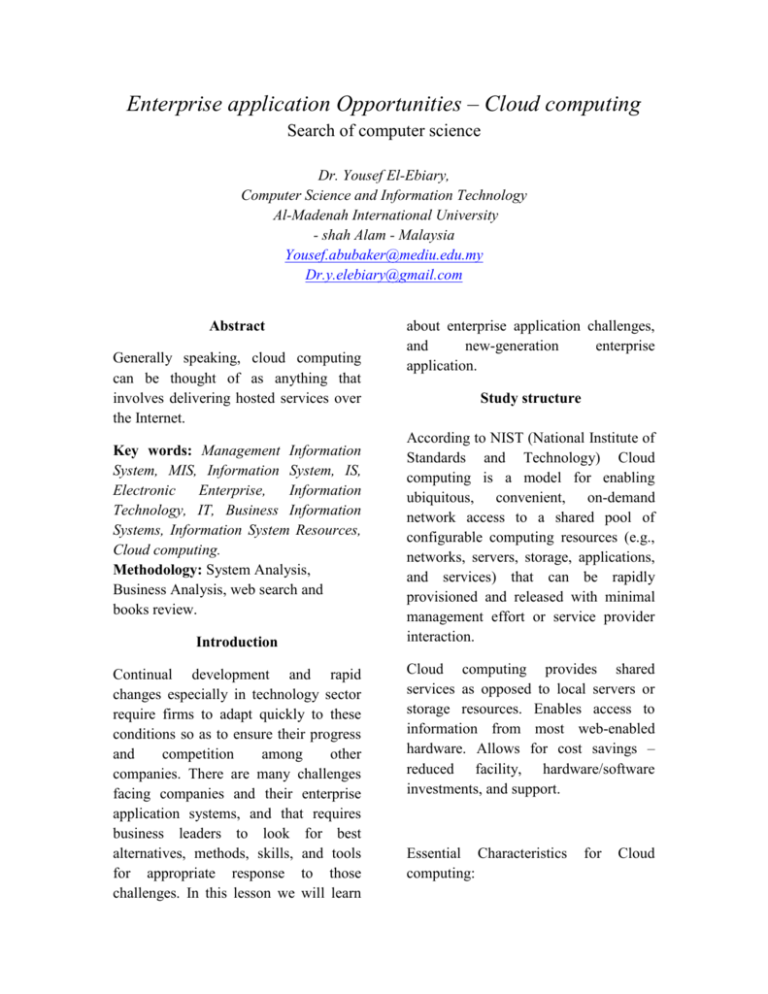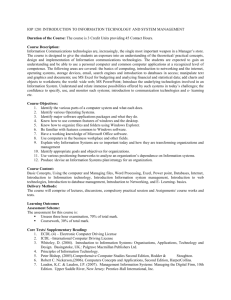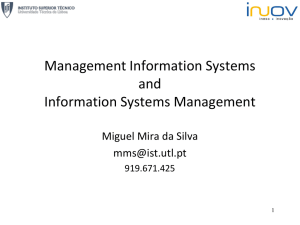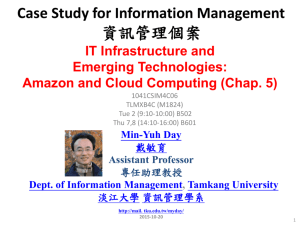50 - cloud computing
advertisement

Enterprise application Opportunities – Cloud computing Search of computer science Dr. Yousef El-Ebiary, Computer Science and Information Technology Al-Madenah International University - shah Alam - Malaysia Yousef.abubaker@mediu.edu.my Dr.y.elebiary@gmail.com Abstract Generally speaking, cloud computing can be thought of as anything that involves delivering hosted services over the Internet. Key words: Management Information System, MIS, Information System, IS, Electronic Enterprise, Information Technology, IT, Business Information Systems, Information System Resources, Cloud computing. Methodology: System Analysis, Business Analysis, web search and books review. Introduction Continual development and rapid changes especially in technology sector require firms to adapt quickly to these conditions so as to ensure their progress and competition among other companies. There are many challenges facing companies and their enterprise application systems, and that requires business leaders to look for best alternatives, methods, skills, and tools for appropriate response to those challenges. In this lesson we will learn about enterprise application challenges, and new-generation enterprise application. Study structure According to NIST (National Institute of Standards and Technology) Cloud computing is a model for enabling ubiquitous, convenient, on-demand network access to a shared pool of configurable computing resources (e.g., networks, servers, storage, applications, and services) that can be rapidly provisioned and released with minimal management effort or service provider interaction. Cloud computing provides shared services as opposed to local servers or storage resources. Enables access to information from most web-enabled hardware. Allows for cost savings – reduced facility, hardware/software investments, and support. Essential Characteristics computing: for Cloud On-demand self-service: A consumer can unilaterally provision computing capabilities, such as server time and network storage, as needed automatically without requiring human interaction with each service provider. Broad network access: Capabilities are available over the network and accessed through standard mechanisms that promote use by heterogeneous thin or thick client platforms (e.g., mobile phones, tablets, laptops, and workstations). Resource pooling: The provider’s computing resources are pooled to serve multiple consumers. Resources can be dynamically assigned and reassigned according to customer demand. Customer generally are not concerned where the resources are physically located but should be aware of risks if they are located offshore. Rapid elasticity: Capabilities can be expanded or released automatically (i.e. more CPU power, or ability to handle additional users). To the customer this appears seamless, limitless, and responsive to their changing requirements. Measured service: Customers are charged for the services they use and the amounts. There is a metering concept where customer resource usage can be monitored, controlled, and reported, providing transparency for both the provider and consumer of the utilized service. Cloud computing Service Models: Infrastructure-as-a-Service (IaaS): A service model that involves outsourcing the basic infrastructure used to support operations--including storage, hardware, servers, and networking components. The service provider owns the infrastructure equipment and is responsible for housing, running, and maintaining it. The customer typically pays on a per-use basis. Platform-as-a-Service (PaaS): A service model that involves outsourcing the basic infrastructure and platform (Windows, Unix). PaaS facilitates deploying applications without the cost and complexity of buying and managing the underlying hardware and software where the applications are hosted. Software-as-a-Service (SaaS): Also referred to as “software on demand,” this service model involves outsourcing the infrastructure, platform, and software/applications. Typically, these services are available to the customer for a fee, pay-as-you-go, or a no charge model. The customer accesses the applications over the internet. Conclusion: Data resides on servers that the customer cannot physically access. References: 1. K. Laudon, J. Laudon, “ Management information system, managing the digital firm”, 12th edition, 2012 2. J. ward, J. Peppard, “Strategic planning for information rd systems”, 3 edition 3. Effy Oz, “Management information systems”, 6th edition 4. Michael E. Porter (1985), Competitive Advantage: Creating and Sustaining Superior Performance. New York. 5. Excerpted from Information Systems Today - Managing in the Digital World, fourth edition. Prentice-Hall, 2010. 6. Excerpted from Management Information Systems, twelfth edition, Prentice-Hall, 2012. 7. Archived from the original on 13 September 2012. Retrieved 13 September 2012. 8. Laudon, Kenneth C.; Laudon, Jane P. (2009). Management Information Systems: Managing the Digital Firm (11 ed.). Prentice Hall/Course Smart. p. 164. 9. Transaction processing systems (TPS) collect and record the routine transactions of an organization. Examples of such systems are sales order entry, hotel 10. reservations, payroll, employee record keeping, and shipping











